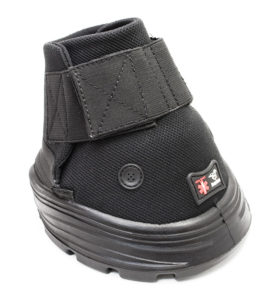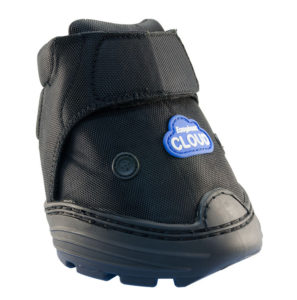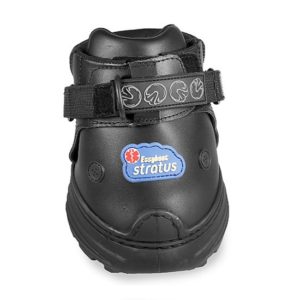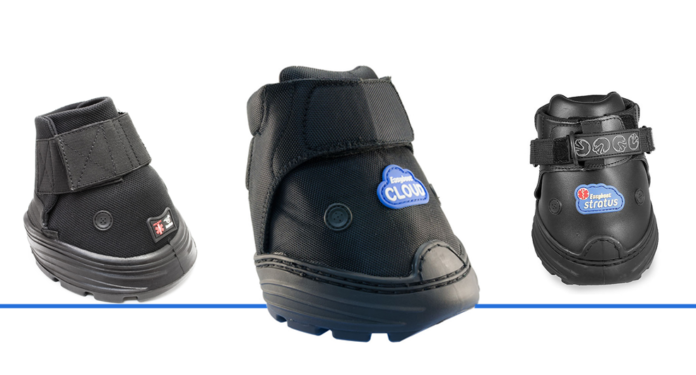By Katie Johanson, EasyCare Product Specialist Team Member
It can be a devastating experience when your horse becomes lame, and it usually marks the beginning of a long, arduous road to recovery before soundness is reclaimed and you can safely hit the trail again. Alongside proper veterinary care, an EasyCare therapy boot can aid in speeding up this process immensely.
EasyCare offers three different boots in its therapy collection:
- Easyboot RX
- Easyboot Cloud
- Easyboot Stratus (recently released)
None of these boots are any better or higher rated than the others. Each boot simply offers a different set of benefits that will help you to decide which one will best help your horse walk comfortably again.
Before we walk through each boot option, let’s discuss how these boots are meant to be used. A horse needing therapy boots is assumed to be in confinement and not moving around much. Because they are intentionally lightweight, these boots are not suitable for turnout, especially when a horse is capable of cantering and playing.
Also, since these boots are typically worn for longer periods of time, they need to be kept in a dry environment. An increase of moisture in the boot not only becomes a haven for bacteria and thrush to flourish, but it also compromises the structure of the boot. Ideally, the boot should be removed every 12 hours to allow it to dry out completely while you check on the hoof. (Tip: If you live in a damp environment, and your horse needs boots on 24 hours a day to be comfortable, have a second set on hand to trade off with. One set can dry for half the day while the other is on the horse’s hooves.)
Now, let’s break down the different boot options!
The Easyboot RX
 Released in 2009, this was EasyCare’s first therapy boot. It’s biggest benefit is that it is ultra light-weight. The size #2 boot weighs less than ¾ lb – significantly less than most boots on the market. When your horse is already stiff and sore from rocking its weight off of a sore foot, the last thing you want is a heavier foot for them to lift! Also, the sole is less than 20 mm at its thickest point, so there isn’t much boot to get in the way of an already difficult stride.
Released in 2009, this was EasyCare’s first therapy boot. It’s biggest benefit is that it is ultra light-weight. The size #2 boot weighs less than ¾ lb – significantly less than most boots on the market. When your horse is already stiff and sore from rocking its weight off of a sore foot, the last thing you want is a heavier foot for them to lift! Also, the sole is less than 20 mm at its thickest point, so there isn’t much boot to get in the way of an already difficult stride.
The Easyboot Cloud
 In 2015, the Cloud made its debut. This boot has made worlds of difference for laminitic horses (find their stories in our blog). Its highlight is the closed-cell comfort pad, which is essentially the equivalent to Crocs for your horse! This pad conforms to the hoof for individualized support through the frog and sole. The pad also has a slight wedge to it that increases the breakover, making those steps a lot easier. The gaiter of this boot is a pliable neoprene which is lightweight and breathable. The size #2 boot is only 1.2 lbs.
In 2015, the Cloud made its debut. This boot has made worlds of difference for laminitic horses (find their stories in our blog). Its highlight is the closed-cell comfort pad, which is essentially the equivalent to Crocs for your horse! This pad conforms to the hoof for individualized support through the frog and sole. The pad also has a slight wedge to it that increases the breakover, making those steps a lot easier. The gaiter of this boot is a pliable neoprene which is lightweight and breathable. The size #2 boot is only 1.2 lbs.
The Easyboot Stratus
 Launched in 2018, EasyCare’s newest therapy boot is the Stratus. The Stratus is our most innovative therapy boot to date. First of all, the outside is made of leather, which is a tougher material that will better withstand outside elements and the wear and tear of everyday use. An internal heel sling also prevents twisting around the hoof. The included TheraPad is a thick gel insert of medium density that can be adjusted to various levels of support in different areas of the hoof. TheraRods can be inserted to completely customize the TheraPad to your horse’s specific needs. For example, the TheraRods can be set to apply more frog pressure or to build up strength in the heel. It is an extremely adaptable boot for different situations.
Launched in 2018, EasyCare’s newest therapy boot is the Stratus. The Stratus is our most innovative therapy boot to date. First of all, the outside is made of leather, which is a tougher material that will better withstand outside elements and the wear and tear of everyday use. An internal heel sling also prevents twisting around the hoof. The included TheraPad is a thick gel insert of medium density that can be adjusted to various levels of support in different areas of the hoof. TheraRods can be inserted to completely customize the TheraPad to your horse’s specific needs. For example, the TheraRods can be set to apply more frog pressure or to build up strength in the heel. It is an extremely adaptable boot for different situations.
The Cloud pad, the TheraPad, and the traditional comfort pads can all be used interchangeably at different points in the recovery process as your horse’s need for support, comfort, and mobility gradually change.
Side note: the Easyboot Cloud also doubles as the perfect shipping boot!
Here at EasyCare, we are also horse owners, and we know how difficult it can be when a horse is laid up any type of lameness. It’s our goal to make that road to recovery as simple and straightforward as possible. And while it’s always important to obtain the advice of your vet and farrier before treating any hoof ailment, we would love to help you find a boot that supports your recovery efforts and leads to success in treatment and, most importantly, soundness in your horse.





